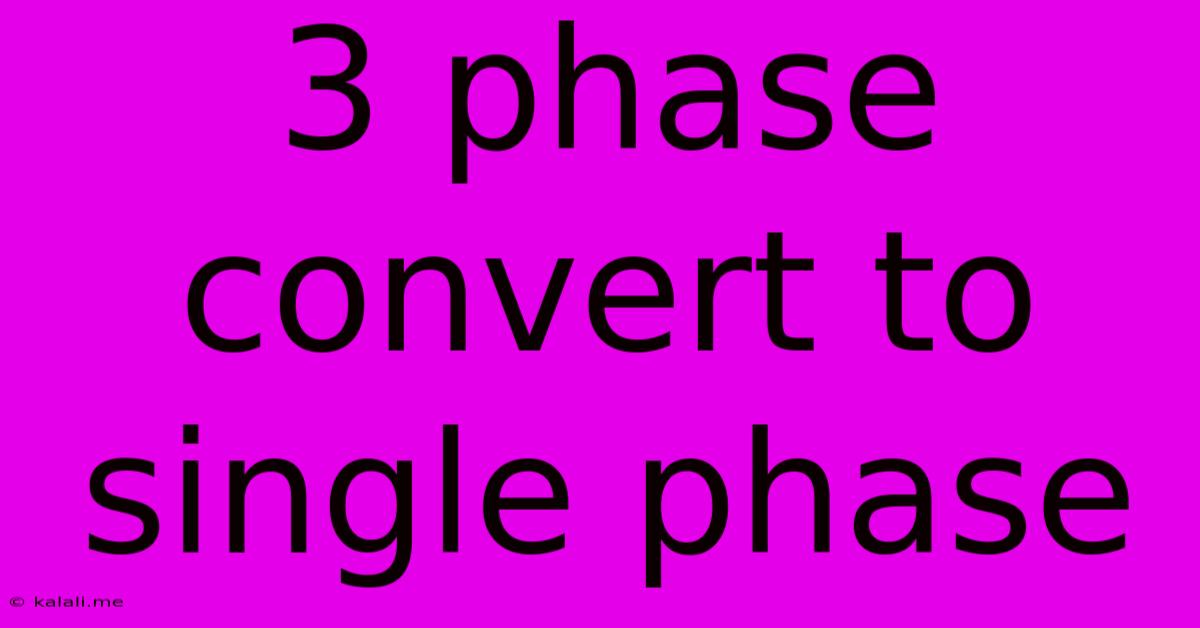3 Phase Convert To Single Phase
Kalali
May 21, 2025 · 3 min read

Table of Contents
3-Phase to Single-Phase Conversion: Methods and Considerations
Converting three-phase power to single-phase power is a common requirement in various applications, from residential settings to industrial installations. This conversion is necessary when single-phase equipment needs to be powered in a three-phase environment, or when a single-phase supply is required from a three-phase source. This article explores the different methods available for this conversion, highlighting their advantages, disadvantages, and important considerations. Understanding these aspects is crucial for selecting the most suitable and efficient method for your specific needs.
Understanding the Differences: 3-Phase vs. Single-Phase Power
Before diving into the conversion methods, it's essential to grasp the fundamental differences between three-phase and single-phase power. Three-phase power consists of three separate AC voltages, each 120 degrees out of phase with the others. This configuration provides higher power capacity and efficiency compared to single-phase power, which uses only one AC voltage. Single-phase power is commonly used in residential settings, while three-phase power is prevalent in industrial applications and large buildings.
Methods for 3-Phase to Single-Phase Conversion
Several techniques exist for transforming three-phase power to single-phase power. The most prevalent methods include:
-
Using One Phase Directly: This is the simplest method, utilizing one of the three phases directly as a single-phase supply. This approach is suitable for low-power applications where the load imbalance on the three-phase system is not a significant concern. However, it's crucial to ensure the load doesn't exceed the capacity of the chosen phase. Load balancing is critical to avoid overloading the system.
-
Scott-T Transformer: This method employs a specially designed transformer to convert three-phase power to two single-phase outputs. The Scott-T transformer is particularly useful for applications requiring two separate single-phase supplies with balanced loads. It provides a more balanced load distribution across the three-phase system compared to simply using one phase. However, it's more complex and expensive than simply using one phase.
-
Phase-Converting Transformer: This type of transformer is specifically designed to convert three-phase power to single-phase power. It's a more efficient method than simply using a single phase, providing better voltage regulation and power quality. This option offers a higher degree of flexibility and often provides better power factor correction capabilities. However, like the Scott-T transformer, it represents a higher initial cost.
-
Static Converter: Static converters, often using electronic components like IGBTs (Insulated Gate Bipolar Transistors) or thyristors, can convert three-phase AC to single-phase AC. These are usually preferred for higher power applications and offer greater control over the output voltage and frequency. This offers advantages in terms of precise power management and reduced harmonic distortion but comes with increased complexity and cost.
Factors to Consider When Choosing a Conversion Method
The selection of the most appropriate method depends on several crucial factors:
-
Power Requirements: The amount of power needed from the single-phase output significantly influences the choice of conversion method. Low-power applications can often utilize a single phase directly, while higher power requirements necessitate transformers or static converters.
-
Cost: The cost-effectiveness of each method varies. Directly using one phase is the most economical, while Scott-T transformers and static converters represent higher initial investments.
-
Efficiency: Efficiency is a key consideration, particularly for higher power applications. Static converters generally offer high efficiency, while simply using one phase can lead to inefficiencies if the load is unbalanced.
-
Load Characteristics: The nature of the load (resistive, inductive, capacitive) affects the choice of method. For example, inductive loads might require additional consideration for power factor correction.
-
Harmonic Distortion: Some conversion methods can introduce harmonic distortion into the system. This is particularly important for sensitive equipment and needs to be managed accordingly.
Choosing the correct 3-phase to single-phase conversion method requires careful consideration of these factors to ensure a safe, efficient, and reliable power supply for your single-phase equipment. Always consult with qualified electricians for complex installations or high-power applications.
Latest Posts
Latest Posts
-
Glue To Stick Metal To Plastic
May 22, 2025
-
1 Cup Of Broccoli To Grams
May 22, 2025
-
How Do I Address A Woman In An Email
May 22, 2025
-
Sourdough Starter Bubbling But Not Rising
May 22, 2025
-
How Do You Put Out Incense
May 22, 2025
Related Post
Thank you for visiting our website which covers about 3 Phase Convert To Single Phase . We hope the information provided has been useful to you. Feel free to contact us if you have any questions or need further assistance. See you next time and don't miss to bookmark.